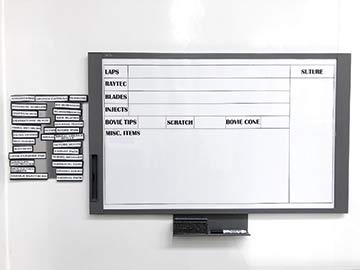- Frontline feedback. A number of perioperative nurses and certified surgical technologists came together to modify our health system's inpatient count worksheet into a custom dry erase board that now hangs in each OR. Staff members who came to our ASC from inpatient units were accustomed to using the standardized count worksheet, but colleagues coming from other outpatient facilities within the health system were already familiar with using a whiteboard to display counts. The group liked the worksheet's format, but wanted the counts visible on an easy-to-reference whiteboard.
- Intuitive design. We combined our internal policy for preventing retained surgical items with AORN guidance to develop a whiteboard used to track soft goods, sharps and miscellaneous items. The count board's design needed to follow the established sequence in which the counts should be conducted (sponges, sharps and miscellaneous items) using the standardized count worksheet as a guide. The staff split into groups to create their ideal board. For example, one group came up with the idea to put the column for sutures on the far right so that additional sutures added to the field could be counted vertically instead of trying to add numbers together horizontally. The groups then came together and designed a board that took into consideration all ideas presented.
- Streamlined choices. One criticism of the inpatient standardized count worksheet was the number of items listed. As a result, the staff determined which items were to be printed on the board and which service-specific items could be noted on magnets and added to the board when needed. The pre-printed items included standard items used frequently such as laps/Raytec sponges, blades, sutures and Bovie tips. The staff then listed the additional, service-specific items such as rubber bands, drill bits and dura hooks that would be noted on magnets. These items could then be added to the board for counts when they're on the field, but wouldn't clutter the board when not in use. (The magnets were created with magnetic tape and a label printer.). These magnets were placed on a separate board that's hung adjacent to the count board for easy access if they're needed.
- Home
- The Magazine
- Article
Safety: Create Your Own Count Board
By: Jillian Bowers
Published: 3/9/2021
The customized tool helps staff keep track of items used during surgery.

- Clear visibility. Once the design of the board was complete, we decided to hang it in each OR on a wall adjacent to the sterile field, so it's easily visible during procedures. It was important that the board hung in a location where it could be easily used during all counts, and visible to all disciplines throughout the procedure.
- Added versatility. We created the dry erase board by printing item categories on a piece of paper that was slid behind a clear plastic covering. That way, the board can be easily altered; if a new item needs to be added, the board can be updated by printing the new template and inserting it behind the plastic. This prevents having to replace the entire board or remove it from the wall when changes need to be made.
The custom count boards were so successful in our facility that we introduced them to three other surgery centers in our health system. Thanks to our in-house project, we now have a standardized approach across all facilities for conducting counts and preventing retained objects. OSM
.svg?sfvrsn=be606e78_3)
.svg?sfvrsn=56b2f850_5)